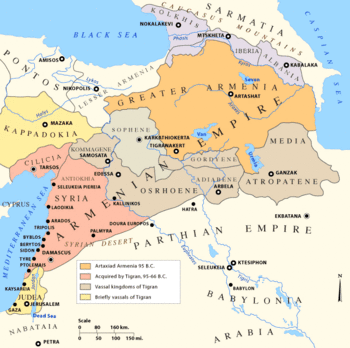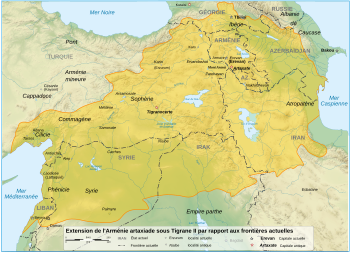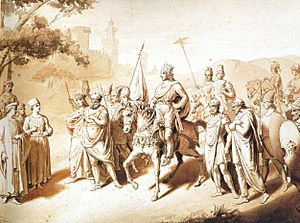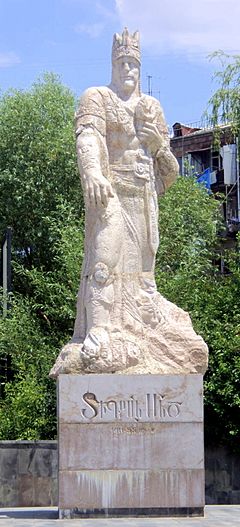Tigranes the Great facts for kids
Quick facts for kids Tigranes the Great |
|
|---|---|
| King of Kings | |
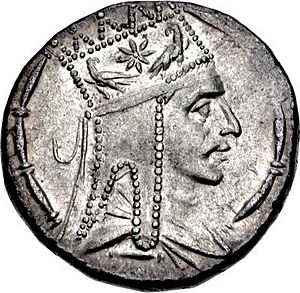
Coin of Tigranes, Antioch mint.
|
|
| King of Armenia | |
| Reign | 95–55 BC |
| Predecessor | Tigranes I |
| Successor | Artavasdes II |
| Born | 140 BC |
| Died | 55 BC (aged 85) |
| Burial | Tigranocerta (modern-day Diyarbakır, Turkey) |
| Consort | Cleopatra of Pontus |
| Issue | Four sons: Zariadres Unnamed Tigranes Artavasdes II Three daughters: Ariazate Unnamed Unnamed |
| Dynasty | Artaxiad |
| Father | Artavasdes I or Tigranes I |
| Mother | Alan princess |
| Religion | Zoroastrianism |
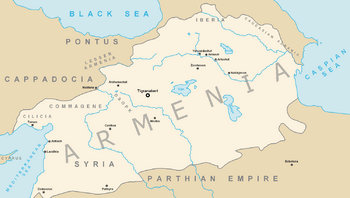
Tigranes II, often called Tigranes the Great, was a powerful king of Armenia. He ruled from 95 to 55 BC. During his time, Armenia became the strongest country east of the Roman Republic. Tigranes was part of the Artaxiad dynasty. He made the Armenian kingdom much bigger than it had ever been. Because of his many victories, he took the special title of Great King. His rule led Armenia into many important battles against empires like the Parthians, the Seleucids, and the Roman Republic.
Contents
Early Life and Becoming King
Around 120 BC, the Parthian king Mithridates II of Parthia attacked Armenia. He forced the Armenian king, Artavasdes I of Armenia, to give him Tigranes as a hostage. This meant Tigranes had to live in the Parthian court in Ctesiphon. He learned a lot about Parthian culture there.
Tigranes stayed a hostage until about 96 or 95 BC. Then, Mithridates II let him go and made him the king of Armenia. To show his loyalty, Tigranes gave Mithridates II some land. His daughter, Ariazate, also married one of Mithridates II's sons. For a while, Tigranes was like a junior partner to the Parthian king.
When Tigranes became king, Armenia already had a strong base. This was thanks to earlier kings of the Artaxiad family. However, Armenia's mountains created natural borders. This meant local noble families, called nakharars, had a lot of power. Tigranes wanted to create a strong, central empire. So, he first made his power firm within Armenia. Then, he began to expand his kingdom.
Working with Pontus
Tigranes made an alliance with Mithridates VI of Pontus, another powerful king. Tigranes married Mithridates VI's daughter, Cleopatra of Pontus. They agreed that Tigranes would expand his power in the East. Mithridates would try to conquer Roman lands in Asia Minor and Europe.
Mithridates planned a big attack on Romans and Italians in Asia Minor. Many local people were unhappy with Roman taxes. About 80,000 people were killed in this event, known as the Asiatic Vespers. This, along with their attempts to control Cappadocia, made the Romans decide to fight back. The Roman Senate sent their general, Lucius Cornelius Sulla, to lead the army against Mithridates.
The famous French historian René Grousset said that in this alliance, Mithridates respected Tigranes greatly.
Battles Against Parthians and Seleucids
After Mithridates II of Parthia died, the Parthian Empire became weaker. This allowed Tigranes II to take over Parthian land in western Mesopotamia.
In 83 BC, the people of Syria, who were ruled by the Seleucids, were having trouble. They asked Tigranes to become their king. Tigranes accepted and conquered Phoenicia and Cilicia. This ended the last parts of the Seleucid Empire. His empire reached as far south as Ptolemais. Many people from the cities he conquered were moved to his new capital, Tigranocerta.
At its peak, Tigranes' empire stretched from modern-day north-eastern Turkey to Mesopotamia. It went from the Caspian Sea to the Mediterranean Sea. Because of his many wins, he took the ancient Persian title of King of Kings. This title was so grand that even the Parthian kings didn't use it. He was called "Tigranes the Great" by many writers. The "King of Kings" never appeared in public without four other kings attending him. The Roman speaker Cicero said that Tigranes "made the Republic of Rome tremble."
Tigranes' coins showed his portrait wearing a special Armenian crown. On the back, they showed the goddess Tyche of Antioch and the river god Orontes.
Wars Against Rome
After fighting Rome, Mithridates VI of Pontus found safety in Armenia. Tigranes was his ally and relative. This brought Tigranes into direct conflict with Rome. The Roman general, Lucullus, demanded that Tigranes hand over Mithridates. Tigranes refused, as this would mean accepting Rome's power over him.
Lucullus attacked quickly, surprising Tigranes. Tigranes sent a general named Mithrobazanes with cavalry to stop the Romans. But Mithrobazanes' horsemen were defeated, and he died. After this loss, Tigranes went north to Armenia to gather a larger army. Lucullus was then free to surround Tigranes' capital, Tigranocerta.
When Tigranes had a big army, he returned to face Lucullus. On October 6, 69 BC, Tigranes' much larger army was badly beaten by the Roman army in the Battle of Tigranocerta. Many people in Tigranocerta had been forced to move there. Unhappy city guards opened the gates to the Romans. Tigranes quickly sent cavalry to rescue his wives and treasures. He himself escaped capture with a small group.
A year later, on October 6, 68 BC, the Romans approached the old capital of Artaxata. Tigranes and Mithridates combined their armies, but they were defeated again. Both kings managed to escape. However, Armenian historians say the Romans lost the battle of Artaxata. They claim Lucullus left Armenia because of this defeat.
Lucullus' soldiers had been fighting for years and were tired. They also felt they weren't getting enough rewards. This led to many soldiers refusing to obey him. The Senate then sent Pompey to take over command from Lucullus.
Pompey and Agreement with Rome
In 67 BC, Pompey was given the job of defeating Mithridates and Tigranes. Pompey first focused on Mithridates. He also encouraged the Parthians to attack Armenia to distract Tigranes. A son of Tigranes, also named Tigranes, joined the Parthians. He convinced the Parthian king, Phraates III of Parthia, to invade Armenia. The son wanted to replace his father as king.
Tigranes decided not to fight the invasion directly. Instead, he made sure his capital, Artaxata, was well protected. He then moved to the hills. Phraates soon realized that Artaxata would be hard to capture. He left Armenia because he feared plots against him back home. Once Phraates left, Tigranes came down from the hills and drove his son out of Armenia. His son then fled to Pompey.
In 66 BC, Pompey entered Armenia with Tigranes the Younger. Tigranes the Great, who was almost 75 years old, surrendered. Pompey allowed him to keep his kingdom, but it was smaller. Pompey wanted Armenia to be a friendly country between Rome and its enemies. Tigranes had to pay a large amount of silver. His disloyal son was sent to Rome as a prisoner.
Tigranes continued to rule Armenia as an ally of Rome until he died in 55 or 54 BC. He was 85 years old.
Family of Tigranes
Tigranes had four sons and three daughters. His oldest son, Zariadres, rebelled against him and was killed. Another son was executed for plotting against Tigranes. His third son, Tigranes the Younger, was loyal and helped his injured father. This son later joined the Parthians and then Pompey against his father. Tigranes was succeeded by his youngest son, Artavasdes II.
One of Tigranes' daughters married Mithridates I of Media Atropatene. Another daughter married a Parthian prince named Pacorus I. Records also mention his third daughter, Ariazate, who married Gotarzes I of Parthia.
Most people think Cleopatra of Pontus was the mother of all his children. However, some historians believe only Artavasdes II and one daughter were her children. They think the others were born before Tigranes married Cleopatra. This is because some of his older children would have been too old to be Cleopatra's children.
Culture and Beliefs
Tigranes' court showed a mix of cultures from his time. The way his court worked was like the ancient Persian Empire, with some Parthian influences. He had Greek speakers and thinkers at his court, possibly because of his queen, Cleopatra. Greek might have been spoken there. Like the Parthians, Tigranes used the title Philhellene, meaning "friend of the Greeks." His capital, Tigranocerta, had a mix of Greek and Iranian building styles.
Like most people in Armenia, Tigranes followed Zoroastrianism, an ancient religion. His crown showed a star and two birds of prey. These were Iranian symbols. The bird of prey was linked to khvarenah, which means kingly glory. It might also have been a symbol of the god Verethragna. The star on his crown might even show Halley's Comet, which appeared in 87 BC.
Legacy and Importance

During his rule, Tigranes founded four cities named after him, including his capital, Tigranocerta.
Historical Mentions
Tigranes is mentioned in Macrobii, a Roman book about famous people who lived long lives.
In his book The Art of War (1521), the Italian thinker Niccolò Machiavelli said Tigranes' army failed because he relied too much on his cavalry.
Many European composers have written operas about Tigranes. There are at least 24 operas, by famous composers like Alessandro Scarlatti and Antonio Vivaldi.
Modern Recognition
For modern Armenian nationalists, Tigranes' short-lived empire is a source of great pride. However, his empire included many different ethnic groups.
The phrase "sea to sea Armenia" (Armenian: ծովից ծով Հայաստան) is a popular saying among Armenians. It refers to Tigranes' kingdom, which stretched from the Caspian Sea to the Mediterranean Sea.
See also
 In Spanish: Tigranes II el Grande para niños
In Spanish: Tigranes II el Grande para niños


